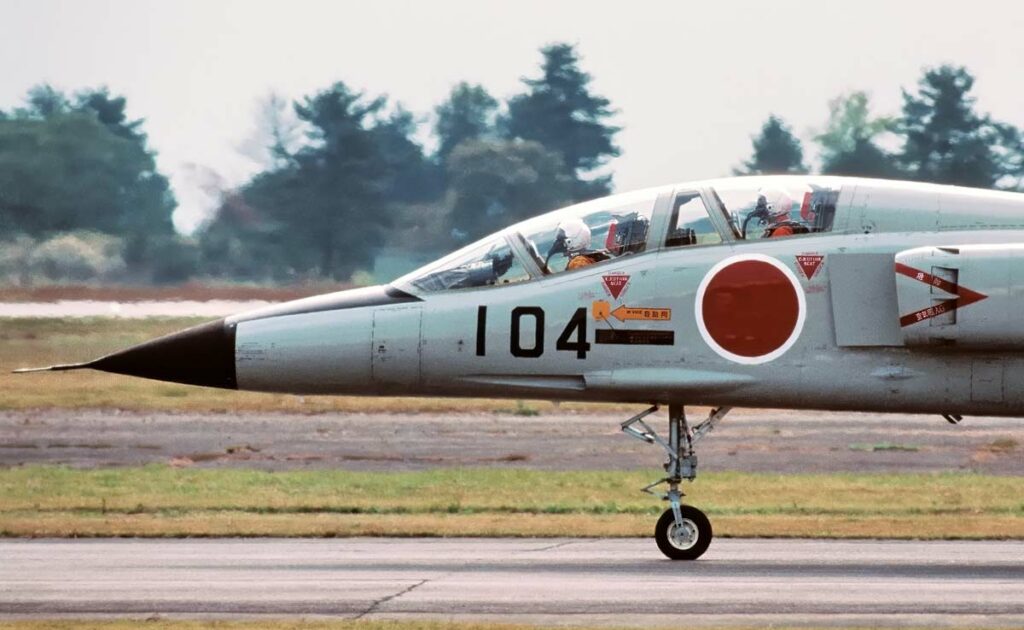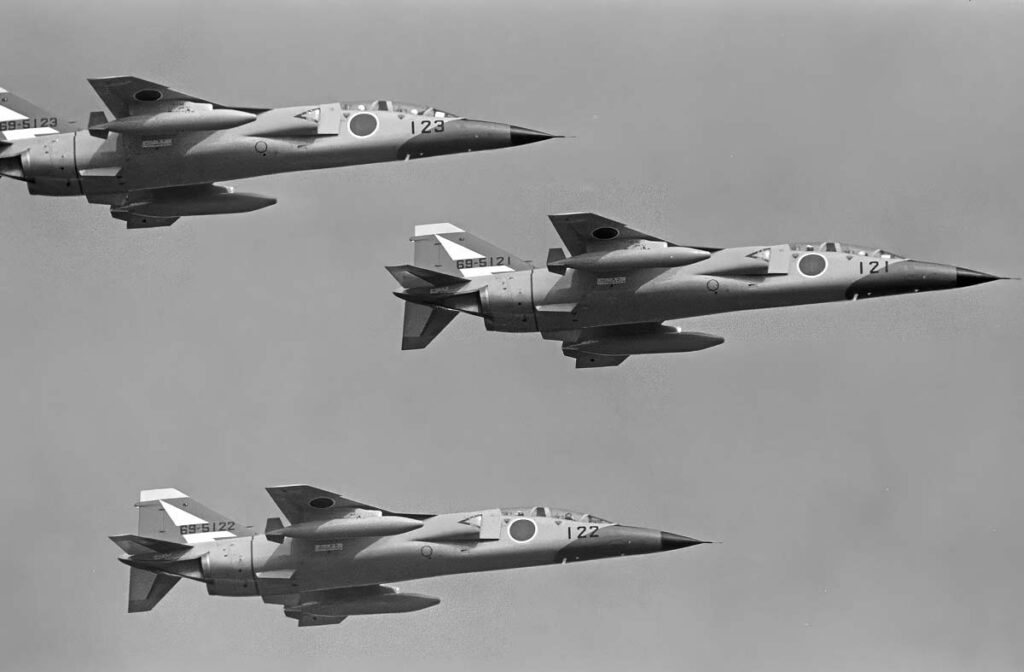Mitsubishi T-2: A supersonic jet trainer/attack aircraft, first supersonic trainer in Japan, served 1975-2006.
In brief
The Mitsubishi T-2 is a supersonic jet trainer that served as the first aircraft of its kind to achieve supersonic speed in Japan. It was developed by Mitsubishi Heavy Industries in collaboration with Fuji Heavy Industries, based partly on the earlier Mitsubishi T-1. The T-2 features a twin-engine design, primarily utilizing two Ishikawajima-Harima TF40-IHI-801A engines, each capable of producing significant thrust to achieve speeds exceeding Mach 1. The aircraft’s design integrates advanced avionics for its time, a dual-seating configuration for trainer roles, and adaptability for light attack missions. It was succeeded by the Mitsubishi F-2 in operational service.

History of the Development of the Mitsubishi T-2
The origins of the Mitsubishi T-2 trace back to the early 1970s, during a period when Japan’s post-war self-defense forces were undergoing significant modernization. In the wake of World War II, Japan re-established its armed forces with a focus on defensive capabilities, leading to the inception of the Japan Air Self-Defense Force (JASDF) in 1954. As technology advanced and the geopolitical landscape evolved, there was a growing need for modernized training aircraft that could adequately prepare pilots for high-speed jet operations.
The development program for the T-2 began in the late 1960s when the JASDF identified a requirement for a new advanced jet trainer that could bridge the gap between basic training aircraft and front-line jet fighters. The project was officially launched in 1971 by Mitsubishi Heavy Industries, with collaboration from Fuji Heavy Industries. The primary objective was to create a platform that could not only serve as a trainer but also handle secondary combat roles.
The T-2 took its first flight on April 20, 1971, marking a pivotal moment in Japanese aviation history. The aircraft was designed to provide pilot trainees with experience in handling jet fighters at supersonic speeds, a capability that was increasingly vital in the modern aerial combat environment. The T-2 did not receive a specific NATO nickname, as it was primarily used within Japan and did not see widespread service or recognition outside of its home country.
Design of the Mitsubishi T-2
The Mitsubishi T-2 was designed as a tandem two-seater, featuring a sleek and aerodynamic profile conducive to its supersonic capabilities. It measured approximately 56 feet in length with a wingspan of 25 feet, and it had an empty weight of around 13,230 pounds, while its maximum takeoff weight stood at about 28,660 pounds. The structure was primarily built from aluminum alloys, with certain high-stress areas reinforced with steel components.
Powering the T-2 were two Ishikawajima-Harima TF40-IHI-801A turbofan engines, each producing 3,085 pounds of thrust dry and up to 5,000 pounds with afterburners. This powerplant enabled the aircraft to reach a maximum speed of over Mach 1.6, with a range of approximately 1,100 miles at cruising speed.
The aircraft’s avionics were advanced for the time, including features designed for both training and light attack roles. It was equipped with sophisticated navigation systems, radar for basic targeting and reconnaissance, and provisions for weapon systems, including air-to-air missiles and bombs.
Despite its advanced capabilities, the T-2 had its drawbacks. The complexity and cost of maintenance were significant, largely due to its twin-engine design and the sophisticated avionics onboard. Furthermore, as a supersonic trainer, it faced operational restrictions and higher fuel consumption compared to subsonic trainers.
Performance of the Mitsubishi T-2
In terms of performance, the Mitsubishi T-2 was a robust platform. Its twin-engine configuration provided a thrust-to-weight ratio that was highly favorable, allowing the aircraft to perform complex aerial maneuvers and reach supersonic speeds effortlessly. The maximum speed achieved was Mach 1.6, equivalent to about 1,200 mph. At this speed, it could operate at an altitude up to 50,000 feet, offering expansive training and operational flexibility.
Comparing the T-2 to its contemporaries, such as the American T-38 Talon, the T-2 was competitive in terms of speed and maneuverability. However, it was more complex and costly to maintain, partly due to its dual-engine design, which was less common in trainer aircraft of the time. This complexity did provide a rigorous training platform for JASDF pilots, preparing them effectively for transitioning to more advanced aircraft such as the F-15J and later the Mitsubishi F-2.
Variants of the Mitsubishi T-2
The Mitsubishi T-2 had several variants throughout its service life. The primary version was the T-2A, the standard trainer model used extensively for advanced pilot training. A secondary variant, the T-2B, was equipped with additional avionics and weapon systems, allowing it to serve dual roles as both a trainer and a light attack aircraft. Another notable variant was the T-2C, a specialized version tailored for specific training missions with advanced radar and targeting capabilities. Each variant maintained the fundamental design and performance characteristics but was adapted for slightly different roles within the JASDF.

Military Use and Combat of the Mitsubishi T-2
In military operations, the T-2 served primarily as a trainer but had capabilities that allowed it to undertake light attack missions if required. Its armament included a variety of air-to-air missiles, bombs, and an internal cannon, making it a versatile asset in combat training scenarios.
The T-2 was never deployed in active combat, serving mainly in training roles throughout its career. However, it played a crucial role in the training of numerous JASDF pilots who later operated Japan’s fleet of more advanced fighters. The aircraft participated in various training exercises and mock combat scenarios, providing realistic preparation for actual combat operations.
Competing directly with aircraft like the American T-38 and later the British Hawk, the T-2 was unique in its combination of speed, dual-role capability, and advanced avionics. It was not exported, remaining exclusive to Japan, reflecting its specialized role within the JASDF.
The T-2 was eventually phased out of active service in 2006, replaced by the more modern and versatile Mitsubishi F-2, which offered greater capabilities and reduced operational costs. The transition to the F-2 marked the end of the T-2’s era but left a lasting impact on the training and preparedness of the JASDF’s pilot corps.
–
The Mitsubishi T-2 was a pioneering aircraft in Japan’s military aviation history, providing a critical bridge for JASDF pilots transitioning from basic trainers to advanced jet fighters. Despite its complexity and operational costs, the T-2 was a valuable asset, contributing significantly to the capabilities and readiness of Japan’s air defense forces.
Back to the Fighter Jet section.